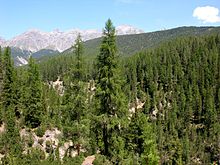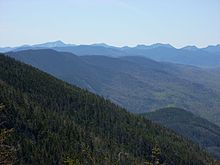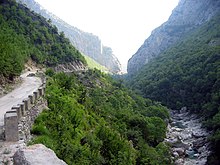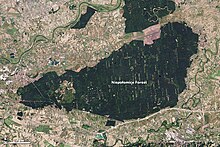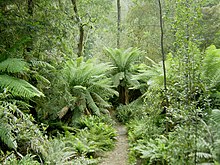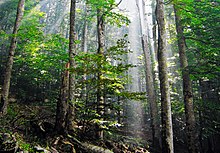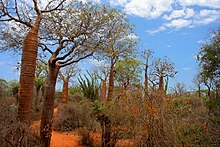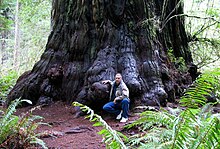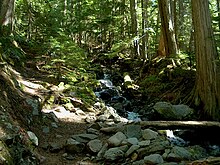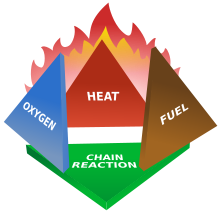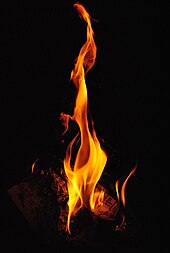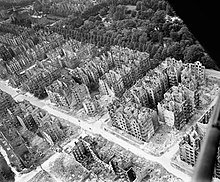A conifer forest in the Swiss Alps (National Park)
The Adirondack Mountains of Upstate New York form the southernmost part of the Eastern forest-boreal transition ecoregion.
Forest on Mount Dajt, Albania
Jungle trail inside Kuala Lumpur International Airport
A forest is a large area dominated by trees.
Hundreds of more precise definitions of forest are used throughout the
world, incorporating factors such as tree density, tree height, land
use, legal standing and ecological function. According to the widely used Food and Agriculture Organization definition, forests covered 4 billion hectares (9.9×109 acres) (15 million square miles) or approximately 30 percent of the world's land area in 2006.
Forests are the dominant terrestrial ecosystem of Earth, and are distributed around the globe. Forests account for 75% of the gross primary production of the Earth's biosphere, and contain 80% of the Earth's plant biomass. Net primary production is estimated at 21.9 gigatonnes carbon per year for tropical forests, 8.1 for temperate forests, and 2.6 for boreal forests.
Forests at different latitudes and elevations form distinctly different ecozones: boreal forests around the poles, tropical forests around the Equator, and temperate forests at the middle latitudes.
Higher elevation areas tend to support forests similar to those at
higher latitudes, and amount of precipitation also affects forest
composition.
Human society and forests influence each other in both positive and negative ways. Forests provide ecosystem services
to humans and serve as tourist attractions. Forests can also affect
people's health. Human activities, including harvesting forest
resources, can negatively affect forest ecosystems.
Definition
Forest in the Scottish Highlands
Although forest is a term of common parlance, there is no
universally recognised precise definition, with more than 800
definitions of forest used around the world.
Although a forest is usually defined by the presence of trees, under
many definitions an area completely lacking trees may still be
considered a forest if it grew trees in the past, will grow trees in the
future, or was legally designated as a forest regardless of vegetation type.
There are three broad categories of forest definitions in use: administrative, land use, and land cover.
Administrative definitions are based primarily upon the legal
designations of land, and commonly bear little relationship to the
vegetation growing on the land: land that is legally designated as a
forest is defined as a forest even if no trees are growing on it.
Land use definitions are based upon the primary purpose that the land
serves. For example, a forest may be defined as any land that is used
primarily for production of timber. Under such a land use definition,
cleared roads or infrastructure within an area used for forestry, or
areas within the region that have been cleared by harvesting, disease or
fire are still considered forests even if they contain no trees. Land
cover definitions define forests based upon the type and density of
vegetation growing on the land. Such definitions typically define a
forest as an area growing trees above some threshold. These thresholds
are typically the number of trees per area (density), the area of ground
under the tree canopy (canopy cover) or the section of land that is occupied by the cross-section of tree trunks (basal area).
Under such land cover definitions, an area of land can only be known as
forest if it is growing trees. Areas that fail to meet the land cover
definition may be still included under while immature trees are
establishing if they are expected to meet the definition at maturity.
Under land use definitions, there is considerable variation on where the cutoff points are between a forest, woodland, and savanna. Under some definitions, forests require very high levels of tree canopy cover, from 60% to 100%, excluding savannas and woodlands in which trees have a lower canopy cover. Other definitions consider savannas to be a type of forest, and include all areas with tree canopies over 10%.
Some areas covered with trees are legally defined as agricultural areas, e.g. Norway spruce plantations in Austrian forest law when the trees are being grown as Christmas trees and below a certain height.
Etymology
Since the 13th century, the Niepołomice Forest in Poland has had special use and protection. In this view from space, different coloration can indicate different functions.
The word forest comes from Middle English, from Old French forest (also forès) "forest, vast expanse covered by trees"; first introduced in English as the word for wild land set aside for hunting without the necessity in definition for the existence of trees. Possibly a borrowing (probably via Frankish or Old High German) of the Medieval Latin word foresta "open wood", foresta was first used by Carolingian scribes in the Capitularies of Charlemagne
to refer specifically to the king's royal hunting grounds. The term was
not endemic to Romance languages (e.g. native words for "forest" in the
Romance languages evolved out of the Latin word silva "forest, wood" (English sylvan); cf. Italian, Spanish, Portuguese selva; Romanian silvă; Old French selve); and cognates in Romance languages, such as Italian foresta, Spanish and Portuguese floresta, etc. are all ultimately borrowings of the French word.
A forest near Vinitsa, North Macedonia
The exact origin of Medieval Latin foresta is obscure. Some authorities claim the word derives from the Late Latin phrase forestam silvam, meaning "the outer wood"; others claim the term is a latinisation of the Frankish word *forhist "forest, wooded country", assimilated to forestam silvam (a common practice among Frankish scribes). Frankish *forhist is attested by Old High German forst "forest", Middle Low German vorst "forest", Old English fyrhþ "forest, woodland, game preserve, hunting ground" (English frith), and Old Norse fýri "coniferous forest", all of which derive from Proto-Germanic *furhísa-, *furhíþija- "a fir-wood, coniferous forest", from Proto-Indo-European *perkwu- "a coniferous or mountain forest, wooded height".
Uses of the word "forest" in English to denote any uninhabited area of non-enclosure are now considered archaic. The word was introduced by the Norman rulers of England as a legal term (appearing in Latin texts like the Magna Carta) denoting an uncultivated area legally set aside for hunting by feudal nobility.
Tywi Forest, Wales
These hunting forests were not necessarily wooded much, if at all.
However, as hunting forests did often include considerable areas of
woodland, the word "forest" eventually came to mean wooded land more
generally.
By the start of the 14th century, the word appeared in English texts,
indicating all three senses: the most common one, the legal term and the
archaic usage. Other terms used to mean "an area with a high density of trees" are wood, woodland, wold, weald, holt, frith and firth. Unlike forest, these are all derived from Old English and were not borrowed from another language. Some classifications now reserve the term woodland for an area with more open space between trees and distinguish among woodlands, open forests, and closed forests based on crown cover.
Evolutionary history
The first known forests on Earth arose in the Late Devonian (approximately 380 million years ago), with the evolution of Archaeopteris. Archaeopteris was a plant that was both tree-like and fern-like, growing to 10 metres (33 ft) in height. Archaeopteris quickly spread throughout the world, from the equator to subpolar latitudes. Archaeopteris formed the first forest by being the first known species to cast shade due to its fronds and forming soil from its roots. Archaeopteris
was deciduous, dropping its fronds onto the forest floor. The shade,
soil, and forest duff from the dropped fronds created the first forest. The shed organic matter altered the freshwater environment, slowing it down and providing food. This promoted freshwater fish.
Ecology
Temperate rainforest in Tasmania's Hellyer Gorge
Forests account for 75% of the gross primary productivity of the Earth's biosphere, and contain 80% of the Earth's plant biomass. Forest ecosystems can be found in all regions capable of sustaining tree growth, at altitudes up to the tree line,
except where natural fire frequency or other disturbance is too high,
or where the environment has been altered by human activity.
The latitudes 10° north and south of the equator are mostly covered in tropical rainforest, and the latitudes between 53°N and 67°N have boreal forest. As a general rule, forests dominated by angiosperms (broadleaf forests) are more species-rich than those dominated by gymnosperms (conifer, montane, or needleleaf forests), although exceptions exist.
Forests sometimes contain many tree species within a small area (as in tropical rain and temperate deciduous forests), or relatively few species over large areas (e.g., taiga and arid montane coniferous forests). Forests are often home to many animal and plant species, and biomass
per unit area is high compared to other vegetation communities. Much of
this biomass occurs below ground in the root systems and as partially
decomposed plant detritus. The woody component of a forest contains lignin, which is relatively slow to decompose compared with other organic materials such as cellulose or carbohydrate.
Components
Even, dense old-growth stand of beech trees (Fagus sylvatica) prepared to be regenerated by their saplings in the understory, in the Brussels part of the Sonian Forest.
A forest consists of many components that can be broadly divided into
two categories that are biotic (living) and abiotic (non-living)
components. The living parts include trees, shrubs, vines, grasses and other herbaceous (non-woody) plants, mosses, algae, fungi, insects, mammals, birds, reptiles, amphibians, and microorganisms living on the plants and animals and in the soil.
Layers
Biogradska forest in Montenegro
Spiny forest at Ifaty, Madagascar, featuring various Adansonia (baobab) species, Alluaudia procera (Madagascar ocotillo) and other vegetation
A forest is made up of many layers. The main layers of all forest
types are the forest floor, the understory and the canopy. The emergent
layer exists in tropical rainforests. Each layer has a different set of
plants and animals depending upon the availability of sunlight, moisture
and food.
- Forest floor contains decomposing leaves, animal droppings, and dead trees. Decay on the forest floor forms new soil and provides nutrients to the plants. The forest floor supports ferns, grasses, mushroom and tree seedlings.
- Understory is made up of bushes, shrubs, and young trees that are adapted to living in the shades of the canopy.
- Canopy is formed by the mass of intertwined branches, twigs and leaves of the mature trees. The crowns of the dominant trees receive most of the sunlight. This is the most productive part of the trees where maximum food is produced. The canopy forms a shady, protective "umbrella" over the rest of the forest.
- Emergent layer exists in the tropical rain forest and is composed of a few scattered trees that tower over the canopy.
Types
A dry sclerophyll forest in Sydney, which is dominated by eucalyptus trees.
Forests can be classified in different ways and to different degrees of specificity. One such way is in terms of the biome in which they exist, combined with leaf longevity of the dominant species (whether they are evergreen or deciduous). Another distinction is whether the forests are composed predominantly of broadleaf trees, coniferous (needle-leaved) trees, or mixed.
- Boreal forests occupy the subarctic zone and are generally evergreen and coniferous.
- Temperate zones support both broadleaf deciduous forests (e.g., temperate deciduous forest) and evergreen coniferous forests (e.g., temperate coniferous forests and temperate rainforests). Warm temperate zones support broadleaf evergreen forests, including laurel forests.
- Tropical and subtropical forests include tropical and subtropical moist forests, tropical and subtropical dry forests, and tropical and subtropical coniferous forests.
- Physiognomy classifies forests based on their overall physical structure or developmental stage (e.g. old growth vs. second growth).
- Forests can also be classified more specifically based on the climate and the dominant tree species present, resulting in numerous different forest types (e.g., Ponderosa pine/Douglas-fir forest).
The number of trees in the world, according to a 2015 estimate, is 3
trillion, of which 1.4 trillion are in the tropics or sub-tropics, 0.6
trillion in the temperate zones, and 0.7 trillion in the coniferous
boreal forests. The estimate is about eight times higher than previous
estimates, and is based on tree densities measured
on over 400,000 plots. It remains subject to a wide margin of error,
not least because the samples are mainly from Europe and North America.
Forests can also be classified according to the amount of human alteration. Old-growth forest contains mainly natural patterns of biodiversity in established seral patterns, and they contain mainly species native to the region and habitat. In contrast, secondary forest is regrowing forest following timber harvest and may contain species originally from other regions or habitats.
Different global forest classification systems have been proposed, but none has gained universal acceptance. UNEP-WCMC's forest category classification system is a simplification of other more complex systems (e.g. UNESCO's
forest and woodland 'subformations'). This system divides the world's
forests into 26 major types, which reflect climatic zones as well as the
principal types of trees. These 26 major types can be reclassified into
6 broader categories: temperate needleleaf; temperate broadleaf and
mixed; tropical moist; tropical dry; sparse trees and parkland; and
forest plantations. Each category is described as a separate section below.
Temperate needleleaf
Temperate needleleaf forests mostly occupy the higher latitude regions of the Northern Hemisphere, as well as high altitude zones and some warm temperate areas, especially on nutrient-poor or otherwise unfavourable soils. These forests are composed entirely, or nearly so, of coniferous species (Coniferophyta). In the Northern Hemisphere pines Pinus, spruces Picea, larches Larix, firs Abies, Douglas firs Pseudotsuga and hemlocks Tsuga, make up the canopy, but other taxa are also important. In the Southern Hemisphere, most coniferous trees (members of the Araucariaceae and Podocarpaceae) occur in mixtures with broadleaf species, and are classed as broadleaf and mixed forests.
Temperate broadleaf and mixed
Broadleaf forest in Bhutan
Temperate broadleaf and mixed forests include a substantial component of trees in the Anthophyta.
They are generally characteristic of the warmer temperate latitudes,
but extend to cool temperate ones, particularly in the southern
hemisphere. They include such forest types as the mixed deciduous
forests of the United States and their counterparts in China and Japan,
the broadleaf evergreen rainforests of Japan, Chile and Tasmania, the sclerophyllous forests of Australia, central Chile, the Mediterranean and California, and the southern beech Nothofagus forests of Chile and New Zealand.
Tropical moist
There are many different types of tropical moist forests, with lowland evergreen broad leaf tropical rainforests, for example várzea and igapó forests and the terra firma forests of the Amazon Basin; the peat swamp forests, dipterocarp forests of Southeast Asia; and the high forests of the Congo Basin. Seasonal tropical forests, perhaps the best description for the colloquial term "jungle", typically range from the rainforest zone 10 degrees north or south of the equator, to the Tropic of Cancer and Tropic of Capricorn. Forests located on mountains are also included in this category, divided largely into upper and lower montane formations on the basis of the variation of physiognomy corresponding to changes in altitude.
Tropical dry
Tropical dry forests
are characteristic of areas in the tropics affected by seasonal
drought. The seasonality of rainfall is usually reflected in the
deciduousness of the forest canopy, with most trees being leafless for
several months of the year. However, under some conditions, e.g. less
fertile soils or less predictable drought regimes, the proportion of
evergreen species increases and the forests are characterised as "sclerophyllous". Thorn forest,
a dense forest of low stature with a high frequency of thorny or spiny
species, is found where drought is prolonged, and especially where
grazing animals are plentiful. On very poor soils, and especially where
fire or herbivory are recurrent phenomena, savannas develop.
Sparse trees and parkland
Taiga forest near Saranpaul in the northeast Ural Mountains, Khanty–Mansia, Russia. Trees include Picea obovata (dominant on right bank), Larix sibirica, Pinus sibirica, and Betula pendula.
Sparse trees and savanna are forests with lower canopy
cover of trees. They occur principally in areas of transition from
forested to non-forested landscapes. The two major zones in which these ecosystems occur are in the boreal region and in the seasonally dry tropics.
At high latitudes, north of the main zone of boreal forest, growing
conditions are not adequate to maintain a continuous closed forest cover, so tree cover is both sparse and discontinuous. This vegetation is variously called open taiga, open lichen woodland, and forest tundra. A savanna is a mixed woodland grassland ecosystem characterized by the trees being sufficiently widely spaced so that the canopy does not close. The open canopy allows sufficient light to reach the ground to support an unbroken herbaceous layer consisting primarily of grasses. Savannas maintain an open canopy despite a high tree density.
Forest plantations
Forest plantations are generally intended for the production of timber and pulpwood. Commonly mono-specific and/or composed of introduced tree species, these ecosystems are not generally important as habitat for native biodiversity.
However, they can be managed in ways that enhance their biodiversity
protection functions and they can provide ecosystem services such as
maintaining nutrient capital, protecting watersheds and soil structure, and storing carbon.
Societal significance
Redwood tree in northern California redwood forest, where many redwood trees are managed for preservation and longevity, rather than being harvested for wood production
Forests provide a diversity of ecosystem services including:
- converting carbon dioxide into oxygen and biomass.
- acting as a carbon sink. Therefore, they are necessary to stop Climate Change. According to the Special Report on Global Warming of 1.5 ºC of the Intergovernmental Panel on Climate Change, to avoid temperature rise by more than 1.5 degrees above pre-industrial levels, there will need to be an increase in global forest cover equal to the land area of Canada (10 million sq. km), by the year 2050.
- aiding in regulating climate. For example a research from 2017, show that forests induce rainfall. If the forest is cut, it can lead to drought.
- purifying water.
- mitigating natural hazards such as floods.
- serving as a genetic reserve.
- serving as a source of lumber and as recreational areas.
Some researchers state that forests do not only provide benefits, but can in certain cases also incur costs to humans. Forests may impose an economic burden, diminish the enjoyment of natural areas, reduce the food producing capacity of grazing land and cultivated land, reduce biodiversity reduce available water for humans and wildlife, harbour dangerous or destructive wildlife, and act as reservoirs of human and livestock disease.
The management of forests is often referred to as forestry. Forest management
has changed considerably over the last few centuries, with rapid
changes from the 1980s onwards culminating in a practice now referred to
as sustainable forest management.
Forest ecologists concentrate on forest patterns and processes, usually
with the aim of elucidating cause-and-effect relationships. Foresters who practice sustainable forest management focus on the integration of ecological, social, and economic values, often in consultation with local communities and other stakeholders.
Priest River
winding through Whitetail Butte with lots of forestry to the east—these
lot patterns have existed since the mid-19th century. The white patches
reflect areas with younger, smaller trees, where winter snow cover
shows up brightly to the astronauts. Dark green-brown squares are
parcels
Humans have generally decreased the amount of forest worldwide. Anthropogenic factors that can affect forests include logging, urban sprawl, human-caused forest fires, acid rain, invasive species, and the slash and burn practices of swidden agriculture or shifting cultivation. The loss and re-growth of forest leads to a distinction between two broad types of forest, primary or old-growth forest and secondary forest. There are also many natural factors that can cause changes in forests over time including forest fires, insects, diseases, weather, competition between species, etc. In 1997, the World Resources Institute recorded that only 20% of the world's original forests remained in large intact tracts of undisturbed forest. More than 75% of these intact forests lie in three countries—the boreal forests of Russia and Canada and the rainforest of Brazil.
In 2010, the United Nations Food and Agriculture Organization
reported that world deforestation, mainly the conversion of tropical
forests to agricultural land, had decreased over the past ten years but
still continues at a high rate in many countries. Globally, around 13
million hectares of forests were converted to other uses or lost through
natural causes each year between 2000 and 2010 as compared to around 16
million hectares per year during the 1990s. The study covered 233
countries and areas. Brazil and Indonesia, which had the highest loss of
forests in the 1990s, have significantly reduced their deforestation
rates. China instituted a ban on logging, beginning in 1998, due to the
erosion and flooding that it caused.
In addition, ambitious tree planting programmes in countries such as
China, India, the United States and Vietnam – combined with natural
expansion of forests in some regions – have added more than seven
million hectares of new forests annually. As a result, the net loss of
forest area was reduced to 5.2 million hectares per year between 2000
and 2010, down from 8.3 million hectares annually in the 1990s. In 2015,
a study for Nature Climate Change
showed that the trend has recently been reversed, leading to an
"overall gain" in global biomass and forests. This gain is due
especially to reforestation in China and Russia.
However new forests are not completely equivalent to old growth forests
in terms of species diversity, resilience and carbon capture.
On September 7, 2015, the Food and Agriculture Organization of the United Nations released a new study stating that, over the last 25 years, the global deforestation rate has decreased by 50% due to improved management of forests and greater government protection.
Smaller areas of woodland in cities may be managed as urban forestry, sometimes within public parks. These are often created for human benefits; Attention Restoration Theory argues that spending time in nature reduces stress and improves health, while forest schools and kindergartens
help young people to develop social as well as scientific skills in
forests. These typically need to be close to where the children live,
for practical logistics.
Canada
Canada has about 4,020,000 square kilometres (1,550,000 sq mi) of
forest land. More than 90% of forest land is publicly owned and about
50% of the total forest area is allocated for harvesting. These
allocated areas are managed using the principles of sustainable forest management,
which includes extensive consultation with local stakeholders. About
eight percent of Canada’s forest is legally protected from resource
development.
Much more forest land—about 40 percent of the total forest land
base—is subject to varying degrees of protection through processes such
as integrated land use planning or defined management areas such as certified forests.
By December 2006, over 1,237,000 square kilometres of forest land
in Canada (about half the global total) had been certified as being
sustainably managed. Clearcutting,
first used in the latter half of the 20th century, is less expensive,
but devastating to the environment, and companies are required by law to
ensure that harvested areas are adequately regenerated. Most Canadian
provinces have regulations limiting the size of clear-cuts, although
some older clear-cuts can range upwards of 110 square kilometres (27,000
acres) in size which was cut over several years.
Latvia
Latvian Pine Forest in Ķegums Municipality
Latvia has about 3,270,000 hectares (12,626 sq mi) of forest land
which equates to 50.6% of Latvia's total area (24,938 sq mi). 1,510,000
hectares of forest land (46.3% of total forest land) is publicly owned
and 1,750,000 hectares of forest land (53.7% of total forest land) is in
private hands. Latvia's forests have been steadily increasing over the
years which is in contrast to many other nations, mostly due to the
forestation of land not used for agriculture. In 1935 there was only
1,757,000 hectares of forest, today this has increased by more than
150%. Birch is the most common tree at 28.2% followed by pine (26,9%),
spruce (18.3%), grey alder (9.7%), aspen (8,0%), black alder (5.7%),
oak/ash (1.2%) and finally hardwood making up the rest (2.0%).
United States
In
the United States, most forests have historically been affected by
humans to some degree, though in recent years improved forestry
practices have helped regulate or moderate large scale or severe
impacts. However, the United States Forest Service
estimates a net loss of about 2 million hectares (4,942,000 acres)
between 1997 and 2020; this estimate includes conversion of forest land
to other uses, including urban and suburban development, as well as
afforestation and natural reversion of abandoned crop and pasture land
to forest. However, in many areas of the United States, the area of
forest is stable or increasing, particularly in many northern states.
The opposite problem from flooding has plagued national forests, with
loggers complaining that a lack of thinning and proper forest management
has resulted in large forest fires.
